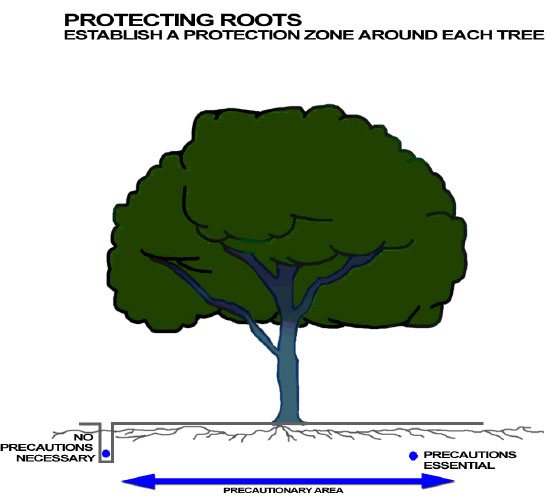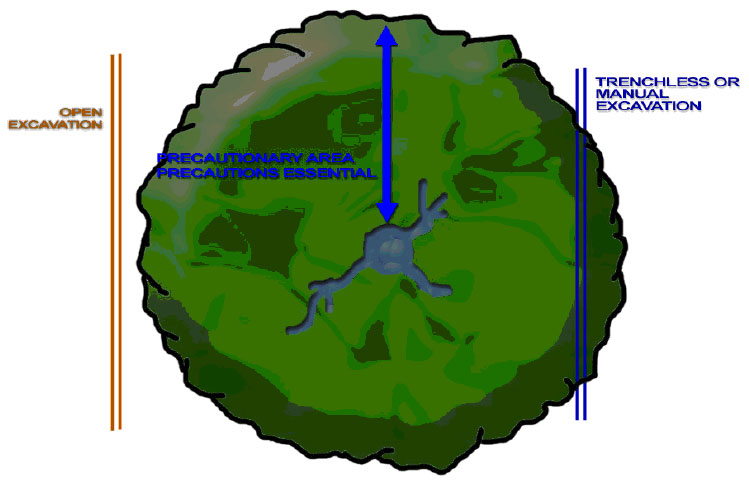Irrigation Systems and Trees
Benefit to Trees
The increased use of underground irrigation systems, including the growing use of the drip-irrigation method, has greatly expanded the variety of plant materials that can be used in the community landscape. In addition to turfgrass, shrubs and trees can benefit from the use of a well-designed and operated irrigation system. Irrigation of trees should be a component of a good Plant Health Care plan and should be considered when developing a strategy for the care and maintenance of trees growing in any landscape. Since drought stresses are often cyclical in many regions of the country, their occurrence should be planned for during the development of any tree management strategy.
Lack of moisture is one of the more severe problems that affects trees growing in a landscape. Trees growing in urban conditions are often more susceptible to this damage, due to reduced soil volumes, poorer soil structure and desiccation. However, trees in any landscape need adequate moisture to survive, and underground irrigation systems can enhance the opportunity for survival. Irrigation of trees can provide benefits that lead to healthier trees, which are more able to withstand other stresses such as insect and disease infestations that might occur. Reducing drought stress through the proper use of an irrigation system can greatly enhance the likelihood of newly planted trees reaching maturity, and can provide older trees with a consistent source of moisture, even during droughty periods.
Damage to Trees
While underground irrigation systems can provide a useful benefit to establishing and growing trees in the landscape, often the installation and improper use of these systems leads to serious tree health issues. Root damage and overwatering are the most common problems associated with underground systems that are installed to irrigate trees or turfgrass.
Root Damage
The long term health of trees can be affected during by the installation of underground irrigation systems as a result of trenching near a tree. Research has shown that tree roots can travel a distance away from the trunk, over 2 1/2 times the height of the tree, and that over 85% of the root growth occurs within 18 inches of the soil surface. Often these roots are severely damaged, or cut entirely, during the installation of the underground piping that makes up the irrigation system.
In many cases trenching, vibratory plowing or earth sawing operations make vertical cuts through the soil to depths that can range to over 20 inches, cutting many tree roots growing in their path. The damage to trees is not readily apparent, but generally begins to appear within months or years of the damage. Dieback, decline and mortality often occur, but the severing of roots during the irrigation installation process is not recalled, since most of the problem took place underground, out of sight of the property owner or contractor.
Arborists can provide advice to irrigation installation contractors on how to minimize damage to trees during the installation process. Arborists should be used in developing a tree protection plan that will minimize potential impacts to the root zones of the trees during the installation of any underground system. Without planning for the protection of trees growing in the vicinity of the installation of an underground irrigation system, tree root damage is likely to occur. The layout, installation and operational plan for the underground irrigation system should be reviewed by an arborist. These reviews provide the opportunity to protect trees and ensure that their healthy growth will continue.
One of the most useful, and tree friendly, techniques for installing irrigation or other utility piping in the vicinity of trees is horizontal directional drilling. This "trenchless technology" involves the use of specialized equipment which uses a boring head to tunnel under the rootzone of a tree, limiting any potential impact to the tree's underground life support system. Since most tree root growth occurs in the top 18 inches of soil, directional drilling is used to pull piping or conduit at depths, which in most cases, are safely below the root zone.
There are several sources of directional drilling equipment, and a variety of models available, depending on the specific application. Units range in size from self contained, small footprint sized units, to larger systems that are used for long-distance utility and telecommunication installations. Today, affordable trenchless technology tools are available from a variety of manufacturers and wide ranges of product specific features are available. Small, easy to maneuver units are extremely versatile and can be used for a variety of applications related to irrigation.


Overwatering
Another serious problem affecting trees as a result of underground irrigation systems is overwatering and soil saturation. Many times an irrigation system is installed and then programmed for "automatic" operation. This often results in overwatering the root zone of trees, resulting in reduced oxygen saturation or shallow root growth. Since many irrigation systems are designed and installed primarily to water turfgrass, the effect on nearby trees is not considered. This often results in watering practices that are detrimental to healthy tree root growth. Additionally, overwatering can result in shallow root growth, resulting in less healthy trees that are more prone to a variety of problems including wind throw and reliance on artificial watering regimes.
However, it is possible for trees and turfgrass irrigation regimes to coexist successfully. Proper watering for good turf growth can compliment healthy tree root growth. Deeper and less frequent watering can encourage healthier root growth for both turf and trees.
Today, there are a variety of opportunities for arborists to become a more integral component in the design of underground irrigation systems. In today's marketplace, tree professionals can provide valuable professional expertise, knowledgeable installation services and a new perspective to underground irrigation construction operations. Helping to protect trees ensures healthy growth and limits the potential impacts due to underground activities. This is a key role that is best filled by a Massachusetts Certified Arborist.
Written by: Dennis Ryan & David Bloniarz
Revised: 09/2011